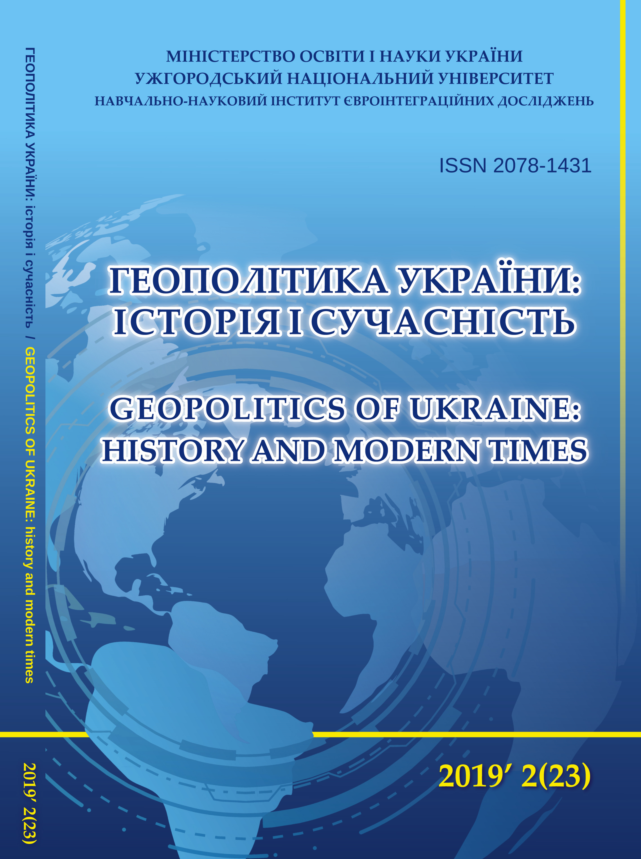Роль етнічності у формуванні якості життя населення
DOI:
https://doi.org/10.24144/2078-1431.2019.2(23).59-70Ключові слова:
добробут, етнос, етнічна ідентичність, меншина, якість життя.Анотація
Дослідження присвячено теоретичному узагальненню впливу етнічних характеристик населення на якість його життя. У статті обґрунтовано необхідність вивчення якості життя в етнічному вимірі. Наведені наукові результати свідчать про статистично значимий вплив певних світоглядних каналів на якість життя. Дослідження поведінкових каналів, що формують соціально-економічний статус етнічної групи, дають неоднозначні результати. Обґрунтовано, що соціально-економічна поведінка окремих етнічних груп обумовлена специфічною комбінацією складових етнічної ідентичності.Посилання
Bader, V. (1997). Ethnicity and class: a proto-theoretical ‘mapping’ exercise. Multiculturalism in North America and Europe: Comparative Perspectives on Interethnic Relations and Social Incorporation. W.W. Isajiw (Ed.).Toronto: Canadian Scholar’s Press[in English].
Gavrilova, T. (2004). Princzipy’ imetody’ issledovani yaka chestva zhizni naseleniya [Principles and methods of researching the quality of life of the population].Tekhnologii kachestva zhizni – Quality of life technology, V. 4, 2, 1–11[in Russian].
World Health Organization Group (1998). Group development of the World Health Organization WHOQOL–Brief quality of life assessment. Psychological Medicine, 28, 551–558[in English].
Organization for Economic Cooperation and Development. OECD Better Life Index. Retrieved from https://www.oecdbetterlifeindex.org/ [in English].
World Bank (2003). Briefing Note. Conference: “Roma in an Expanding Europe: Challenges for the Future.” Retrieved from http://documents.worldbank.org/curated/en/872391468749375351/Roma-in-an-expanding-Europe-Challenges-for-the-future [in English].
European Commission Directorate (2004). The situation of Roma in an enlarged European Union. Luxembourg: Office for official publications of the European Communities. Retrieved from https://publications.europa.eu/en/publication-detail/-/publication/b628783f-622a-4e33-9133-141329672d6e [in English].
United Nations Development Programme (2006). At risk: Roma and the displaced in Southeast Europe. Bratislava: Regional Bureau for Europe. Retrieved from https:// www.eurasia.undp.org/content/rbec/en/home/library/roma/At-risk Roma-displaced-Southeast-Europe.html [in English].
Cahn, C., & Guild, E. (2008). Recent migration of Roma in Europe. Vienna: Organization for Security and Cooperation for Europe. Retrieved from http://www.osce.org/hcnm/78034 [in English].
Ivanov, A., & Kling, J. (2012).Integrated Household Surveys among Roma Populations: One Possible Approach to Sampling Used in the UNDP-World Bank-EC Regional Roma Survey 2011. Bratislava: UNDP. Retrieved from https://www.undp.org/content/dam/rbec/docs/Roma-household-survey-methodology.pdf[in English].
Brega,G. (2018). E’tnicheskie osobennosti e’konomicheskogo povedeniya. [Ethnic features of economic behavior].Moscow: Prommetey[in Russian].
Driedger, L. (1996). Multi-Ethnic Canada Identities and Inequalities. Toronto: Oxford University Press [in English].
Sanina, T. (2005). Doslidzhennia natsionalnoi ta etnichnoi identychnosti: teoretychnyi ohliad [Exploring national and ethnic identity: A theoretical overview]. Naukovi zapysky NAuKMA. Ser. Sotsiol. Nauky – NAUKMA Scientific Notes. Series Sociological Sciences, 46,22-26 [in Ukrainian].
Bernal, M. E., Knight, G. P., Ocampo, K. A, Garza, C. A., & Cota, M. K. (1990). The development of ethnicidentity in Mexican American children. Hispanic Journal of Behavioral Science, 2,3–24 [in English].
Phinney, J. S. (2000). Ethnic and racial identity: Ethnic identity. Encyclopedia of psychology, Vol. 3, 254–259 [in English].
Kysla, H. (2010). Etnosotsialne vymiriuvannia zhyttievykh tsinnostei osobystosti [Ethno-social measurement of the vital values of the individual]. Mizhnarodnyi naukovyi forum: sotsiolohiia, psykholohiia, pedahohika, menedzhment - International scientific forum: sociology, psychology, pedagogy, management, V. 2, 26-32 [in Ukrainian].
Borusevych, O. (2000). Mizhpokolinna transformatsiia etnichnykh tsinnostei (na prykladi ukrainskoho etnosu Ukrainy) [Intergenerational Transformation of Ethnic Values (on the Example of Ukrainian Ethnicity in Ukraine)]. Extended abstract of candidate’s thesis. Kyiv[in Ukrainian].
Pavlov, K. (2016). Etnomenedzhment y Etnoekonomyka [Ethnomenagement and Ethnoeconomics]. Ekonomichnyi visnyk Donbasu – Donbass Economic Bulletin, 1(43),131-141 [in Ukrainian].
Sussel, Y. (2015). Sotsialna kauzalna atrybutsiia protsesu etnichnoho spozhyvannia [Social causal attribution of the process of ethnic consumption]. Aktualni problemy filosofii ta sotsiolohii – Topical problems of philosophy and sociology, 3,161-165 [in Ukrainian].
Ievtukh, V. Troshchynskyi, V.,& Halushko, K. (2003). Etnosotsiolohiia: terminy ta poniattia [Ethnosociology: Termsand Concepts]. Kyiv: Phoenix [in Ukrainian].
Blinova, O. (2014). Rol etnichnykh stereotypiv u mizhkulturnomu otsiniuvanni studentskoi molodi [The role of ethnics tereotypes in intercultural assessment of student youth]. Problemy suchasnoi psykholohii – Problems of modern psychology, 23, 68-78 [in Ukrainian].
Henry, R., Tator, C., Mattis, W., & Rees, T. (1995). The Colour of Democracy: Racism in Canadian Society. Toronto: Harcourt Brace and Co. Canada. [in English].
Smith, E. J. (1991). Ethnic identity development: Toward the development of a theory within the context of majority/minority status. Journal of Counseling and Development, 70, 181–188 [in English].
Michalos, A. C., & Zumbo, B. D. (2001). Ethnicity, modern prejudice and the quality of life. Social Indicators Research., №53(2), pp. 189–222. [in English].
Thumboo, J., Fong, K.-Y., Machin, D., Chan, S.-P., Soh, C.-H., Leong, K.-H. … Boey, M.L.(2003). Quality of life in an urban Asian population: the impact of ethnicity and socio-economic status. Social Scienceand Medicine,56 (8), 1761-72 [in English].
Barger, S. D., Donoho, C. J., & Wayment, H. A. (2008). The relative contributions of race/ethnicity, socioeconomic status, health, and social relationships to life satisfaction in the United States. Quality of Life Research, 18(2), pp. 179–189 [in English].
Zdrenka, M., Yogeeswaran, K., Stronge, S., & Sibley, C. (2015). Ethnic and national attachment as predictors of wellbeingamong New Zealand Europeans, Māori, Asians, and Pacific Nationspeoples. International Journal of Intercultural Relations, 49, 114-120 [in English].
Smith,T.B., Silva, L. (2011). Ethnic Identity and Personal Well-Being of People of Color: A Meta-Analysis. Journal of Counseling Psychology, 58, 56-64 [in English].
Nazroo, J. (1998). Genetic, cultural or socioeconomic vulnerability? Explaining ethnic inequalities in health. Sociology of Health & Illness, 20(5), 710–730 [in English].
##submission.downloads##
Опубліковано
Номер
Розділ
Ліцензія
Автори, які публікуються у цьому журналі, погоджуються з наступними умовами:
- Автори залишають за собою право на авторство своєї роботи та передають журналу право першої публікації цієї роботи на умовах ліцензії Creative Commons Attribution License, котра дозволяє іншим особам вільно розповсюджувати опубліковану роботу з обов'язковим посиланням на авторів оригінальної роботи та першу публікацію роботи у цьому журналі.
- Автори мають право укладати самостійні додаткові угоди щодо неексклюзивного розповсюдження роботи у тому вигляді, в якому вона була опублікована цим журналом (наприклад, розміщувати роботу в електронному сховищі установи або публікувати у складі монографії), за умови збереження посилання на першу публікацію роботи у цьому журналі.
- Політика журналу дозволяє і заохочує розміщення авторами в мережі Інтернет (наприклад, у сховищах установ або на особистих веб-сайтах) рукопису роботи, як до подання цього рукопису до редакції, так і під час його редакційного опрацювання, оскільки це сприяє виникненню продуктивної наукової дискусії та позитивно позначається на оперативності та динаміці цитування опублікованої роботи (див. The Effect of Open Access).


